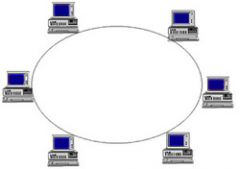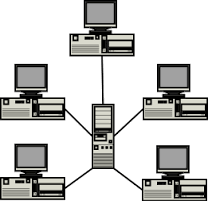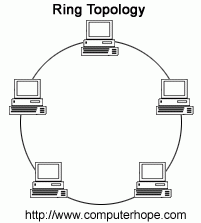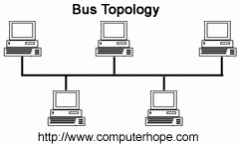![]()
![]()
![]()
Use LEFT and RIGHT arrow keys to navigate between flashcards;
Use UP and DOWN arrow keys to flip the card;
H to show hint;
A reads text to speech;
25 Cards in this Set
- Front
- Back
|
Name the 6 factors that influence the choice of a network. |
- Cost of Network - Size of Organisation - How the system will be used - Existing systems - Performance required - Security issues |
|
|
Name the costs associated with a network. |
- Maintenance costs - Staffing costs - Hardware costs - Training costs - Software costs - Costs of third party communication line |
|
|
Why can the existing system influence the new system that would be introduced? |
To be compatible with existing hardware and software. |
|
|
Name the two main types of Networks. |
Peer to Peer and Client Server |
|
|
Show the diagram for a Peer to Peer Network |

|
|
|
Show the diagram for a Client Server Network |

|
|
|
Advantages of a Peer to Peer network |
- Relatively low cost - no expensive server needed - No need to hire a network manager - Easy to set up - simple - Lower operating cost (maintenance) |
|
|
Disadvantages of a Peer to Peer network |
- No possibility of a central backup - Users need more IT knowledge - they are responsible - Poorer security - Network cannot have more than 15 computers connected - System can be slow when running complicated software - If a single computer goes down, the network breaks down. |
|
|
Advantages of a Client Server network |
- Better security - Data is stored centrally - Regular backups stored on the server - Faster access to programs - Users do not need as much IT knowledge, all complicated administration can be done centrally - Network can continue to run if one computer goes down |
|
|
Disadvantages of a Client Server network |
- More expensive - due to server cost - Often requires a technician with specialist IT knowledge - If the server breaks down, none of the computers connected to the network can be used. |
|
|
Show the diagram for the ring topology |

|
|
|
Show the diagram for the star topology |

|
|
|
Show the diagram for the bus topology |

|
|
|
What is a Hotspot? |
A region where the internet can be accessed wirelessly. |
|
|
What is WiFi |
A trademark for the certification of products that meet certain standards for transmitting data over wireless networks. |
|
|
Advantages of WiFi. |
- Inexpensive - no cost of cabling - More freedom - people have more flexible working conditions when they are not limited by the length of the cabling. - Can be used in listed buildings, where the construction of cabling cannot be installed - WiFi is used around the world - Global connection. |
|
|
Disadvantages of WiFi. |
- High power consumption - Possible health problems* - Security problems are known to occur where encryption in used. - Limited range - Interference in areas where WiFi signals overlap. |
|
|
Name the two unique series of characters that the user must enter in order to gain access to some systems? |
Username and Password |
|
|
What are 'Windows', 'Linux' and 'UNIX' examples of? |
Network Operating Systems software |
|
|
Within a network, what can be used to determine which user has misused the computer network? |
User accounts and User logs |
|
|
What security strategies can an organisation employ to protect their network from potential threats? |
- Use of Usernames and Passwords - Up-to-date Virus checking software - Up-to-date Firewall software and/or hardware - Encryption |
|
|
What are disaster Recovery plans? |
How the company plans to react is after a disaster; where the lost of hardware, software, data and/or communication services occur. |
|
|
The ability for Network Managers/Administrators to 'check which internet sites have been visited by employees' is an example of? |
Remote Management |
|
|
Backups |
Where copies of data are made in case disasters occur. |
|
|
Auditing |
This keeps a record of who has done what on the network. This keeps record of: - Usernames - Times that the user has used the network (login and log off) - Details of files accessed - Details of changes made |

